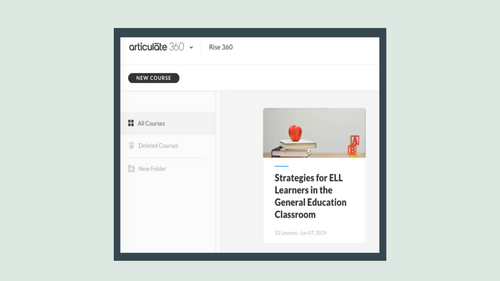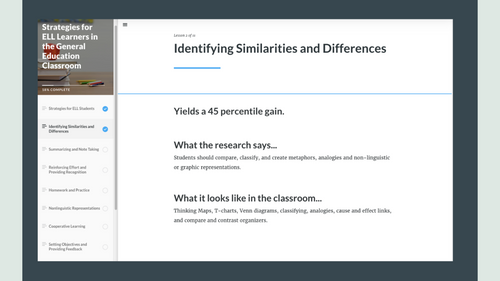.png)
JENNY MALLOY
INSTRUCTIONAL DESIGN
Strategies for ELL Learners in the General Education Classroom
I designed and developed this asynchronous eLearning course using Articulate RISE 360. It was designed for K-12 school teachers and was intended to inform the learner about high yield teaching strategies based on the book Classroom Instruction that Works: Research-based Strategies for Increasing Student Achievement by Robert Marzano.
This project emerged as part of a school district-wide goal to support teachers in fostering success for the growing number of English Language Learner students in their classrooms. This was identified as a need through end of year surveys completed by the teachers and student assessment metrics indicating lower achievement for bilingual and multilingual learners across the district.
_edited.jpg)
TOOLS
-
Articulate RISE 360
AUDIENCE
-
K-5 Teachers
LEARNING SOLUTION
-
eLearning Course
Take a Look

Hi there, I’m Jenny Malloy and this is Strategies for ELL Learners in the General Education Classroom. I designed and developed this asynchronous eLearning course using Articulate RISE 360. It was designed for K-12 school teachers and was intended to inform the learner about high yield teaching strategies based on the book Classroom Instruction that Works: Research-based Strategies for Increasing Student Achievement by Robert Marzano.
The idea for this project emerged as part of a district-wide goal to support teachers in fostering success for the growing number of English Language Learner students in their classrooms. This was identified as a need through end of year surveys completed by the teachers and student assessment metrics indicating lower achievement for bilingual and multilingual learners across the district.
The plan for this eLearning course was to offer the asynchronous training as part of the district sponsored professional development initiative. Teachers could select training that aligned with their goals for the school year. They were motivated to complete the training in order to develop their teaching skill sets and move forward on the pay scale.
The main objectives of this training were for learners to classify, recall, and select the most appropriate high yield strategies for various scenarios involving ELL students.
The main objective of this training was for learners to get hands-on experience with effective teaching strategies like active learning, using vertical whiteboards, and flexible groupings. They would do this by watching a video showcasing the Building Thinking Classrooms model in action and take some time to reflect on what they learn about these practices. Finally, the goal was to put these strategies into practice by incorporating them into their own classroom lessons thus increasing teacher effectiveness and student achievement.
Take a look at some examples from the training.
After gaining the learners’ attention and stating the training objectives participants completed a sorting activity to activate any prior knowledge on best practices for teaching English Language Learner students..
Learners were then expected to click through 9 informational modules with carefully selected relevant images to help make the content more memorable. Text was kept to a minimum and real life classroom applications relevant to the participating demographic were included to increase relevance.
Learners were made aware from the beginning of the course that there would be a short assessment at the end of the 9 modules, and are therefore motivated in the short term to recall and apply knowledge gained from the course. Questions were carefully selected to ensure rote memorization was not assessed, but rather true understanding and application of content was achieved. For example, matching activities and scenario based questions with more than one correct answer were utilized. A passing score on the quiz was required to complete the course and the participants had an opportunity to review the modules and repeat the summative assessment.
Feedback and Evaluation of the training was conducted through the use of a google form based on the Kirkpatrick model.
Questions relating to the learners’ reaction, understanding of the content, changes in behavior, and overall system wide results were collected. The data was then analyzed by district leaders to determine next steps in professional development course offerings or additional learning solutions.
Upon reflection on the analysis of the data. an asynchronous eLearning course offering was an efficient way to deliver meaningful, memorable, and motivational content to a large school district and positively contributed to student and teacher success. Additional instructor led training was considered for individual schools as a follow up to target areas of continued focus.
Thanks for checking out my project. Please connect with me if you want to learn more about how I can contribute to the success of your organization.











